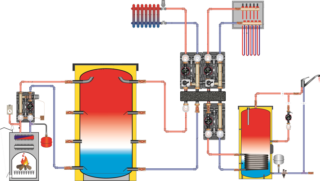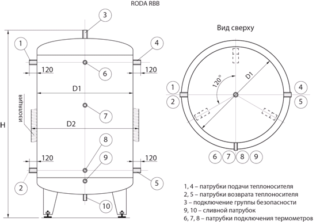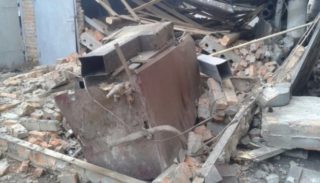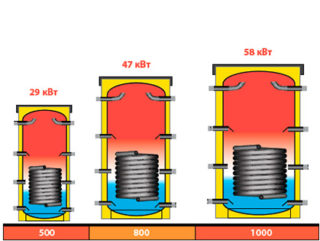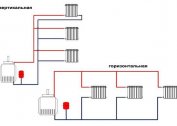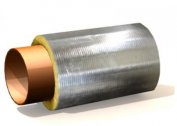Often in suburban homes and cottages where there is no centralized gas, an autonomous system is used in which a solid fuel boiler is a heat source. This equipment has many advantages, but it also has disadvantages, for example, uneven generation of thermal energy during combustion and the need for frequent reloading of fuel. To make heating efficient, an optional fixture can be used. A buffer tank for a solid fuel boiler is a unit that accumulates excess thermal energy and gives it away when it cools. Structurally, the device is a water tank with a coil and a heat-insulating layer.
Buffer capacity assignment
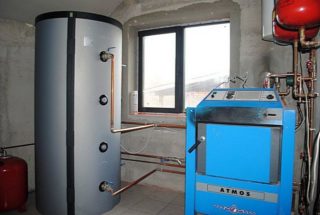
The main objective of the heat accumulator is to save energy in the heating system. Other tasks that the device solves:
- Simultaneous connection of several heat sources.
- Saving solid fuel up to 45-50% of the original amount.
- Stabilization of heating, reducing the risk of overheating of metal components.
- Protection against cooling the premises, automation of heating, which is especially important if the owner leaves the house for a long time and does not want the building to freeze.
- Increasing the life of a solid fuel boiler.
- The lack of the need for frequent replenishment of fuel, the interval between the tossing of firewood or coal into the furnace increases.
Using a buffer makes the heating autonomous system more secure. Solid fuel will be able to completely burn in the furnace, the amount of soot deposits is reduced, equipment maintenance is required less often.
Using a heat accumulator
The buffer tank for heating allows you to adjust the thermal regime, preventing the temperature from dropping to too low a value. The efficiency of heating with a solid fuel boiler decreases as the combustion of firewood or coal; when tossing a new portion of fuel, on the contrary, the amount of heat generated increases sharply. The buffer tank takes on excess energy, transferring heat to the system in a metered amount. In some cases, the heat exchanger additionally works as a hydraulic arrow, in the most advanced designs it is used to provide hot water supply.
As a rule, the transfer of thermal energy from the buffer occurs at night, when tenants sleep, and do not throw firewood or coal into the furnace. This allows heating the rooms of the house for as long as possible, so in the morning it will not be cold in the rooms. In some cases, a buffer tank is also installed in systems where an electric boiler serves as a heat source: this increases the level of fire safety.
The specifics of the buffer tank
Structurally, the heat exchanger consists of several elements, each of which performs a separate function:
- Stainless steel spiral. This component is installed in models connected to heating systems with various coolants used simultaneously (solar collectors, pumps, etc.).
- Capacity. The tank is made of sheet metal, the surfaces are enameled, in some models the walls are made of stainless steel, so they are not subject to corrosion.The energy efficiency of the structure and the duration of the construction itself depend on the volume. Branch pipes depart from the tank, with the help of which the heat exchanger is connected to the boiler.
- A hot water coil is included in the scheme of most modern buffer tanks.
The device is equipped with a revision window used in the repair of equipment. The specialist will be able to determine in time that it is time to clean the equipment, and will perform scheduled or emergency maintenance faster.
Advantages and disadvantages
The use of the buffer has many positive qualities:
- Increased reliability, protection of heating equipment from overheating, which can provoke a fire or explosion.
- Increased boiler efficiency, the most efficient use of energy generated during fuel combustion.
- A relatively simple principle of operation, due to which the equipment has a long life, rarely requires maintenance and repair.
- Smooth temperature control, maintaining optimal microclimatic conditions in the premises for 7-9 hours.
- Possibility of connecting to a water supply system, no need to mount a separate water heater for a bathroom or kitchen.
- Minimization of human efforts to maintain the boiler room.
- The ability to connect multiple heat sources, the competent distribution of heating in several rooms.
Installing a buffer has a number of disadvantages that need to be taken into account when calculating equipment and purchasing a device. The capacity weighs a lot and is large enough, freight transport is necessary for transportation, and installation requires a large area and room height. Another problem is the increased inertia of the boiler equipment: heating the rooms will take a long time, which is especially unpleasant when the house is heated after the end of the winter season. Another drawback is the increased price of the heat exchanger itself: the amount may be more than the cost of the solid fuel boiler itself.
Calculation of the volume of the heat accumulator
Before buying a device, you need to correctly calculate the tank volume. The standard formula isQ = c × m × (T1-T2), wherein:
- Q - total amount of energy expended;
- c - indicator of specific heat;
- m - mass of the heat carrier;
- under indicators T1-T2 understand the temperature difference.
The obtained result needs to be adjusted taking into account additional nuances, including the availability of auxiliary sources, insulation quality, house area, etc. If there are difficulties with the calculations, you need to contact specialists who will study the drawing of the heating system and determine the volume, taking into account all factors.
Model selection
To select the capacity, you need to pay attention to the maximum pressure, the material of manufacture of the internal elements, the ability to connect the heating elements for backup heating, the quality of thermal insulation.
The finished design must meet the criteria of safety, energy efficiency and be practical in maintenance.
It is advisable to prefer the models offered by trusted manufacturers when buying, because in this case the risk of quality problems is minimal.
